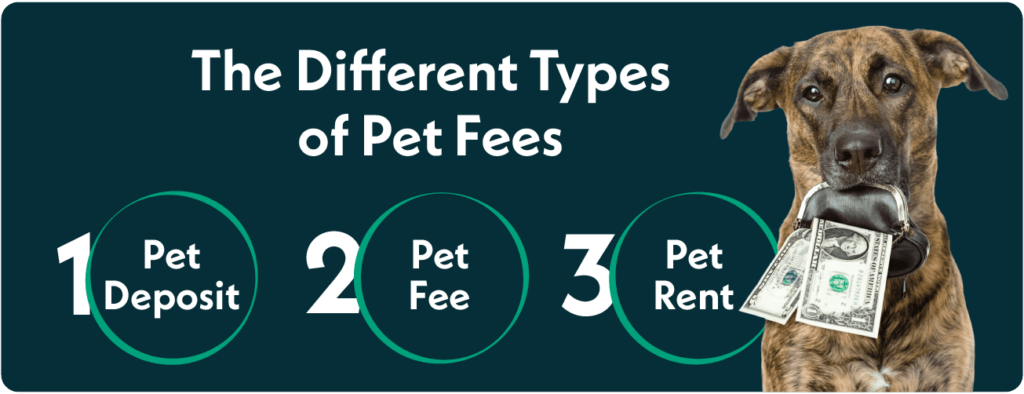Understanding Pet Fees: How to Avoid Additional Housing Charges

Pet fees provide financial security for landlords with pet-friendly policies. The fees usually vary depending on the landlord’s rent policies and the owner’s pet type. For landlords, these fees ensure that animal-related costs will be sorted without paying out of pocket.
Pet-associated fees make life easier for landlords, especially regarding property maintenance and repairing pet-induced damages. For pet owners, however, the costs can prove too much, especially if you have to pay pet deposits and pet rent. The costs can get higher, depending on location, which presents a massive challenge for pet parents who cannot do without their furry companions.
What Are Pet Fees?
Pet Fees act as a safety net for landlords. With over 70% of American renters owning pets, the importance of pet fees to landlords (and tenants to some extent) cannot be overstated. For landlords, the fees help secure the property from pet-related damages. The fees usually come in handy when repairing damages caused by pets or just maintaining the property.
Tenants are usually required to pay the fees to landlords, depending on the details provided in the rental contract. Landlords typically charge three types of fees: pet deposits, fees, and rent. The costs will vary depending on the location, rental policies, and the type (and size) of pet you own.
The Different Types of Pet Fees
Most landlords charge three types of pet fees, as explained below.

Pet Deposit
A pet deposit is similar to the security deposit paid by tenants. They’re usually refundable and can range anywhere between $200 to $500 per pet. Landlords set up pet deposits to help deal with potential damages pets can cause. And since the deposits are refundable, they act as incentives to pet owners to protect their property and prevent pet-related damages.
Pet Fee
Pet fees are non-refundable fees charged to pet owners looking to rent property. A pet fee is paid once and provides advance compensation to landlords for any repairs or upgrades needed. The pet fee usually ranges from landlord to landlord and depends on factors such as the type of pet and location.
Pet Rent
Pet rent, as the name suggests, is additional rent charged by landlords payable monthly. The rent is mostly charged per pet, meaning you may have to pay more if you have many pets. Although not as common as a pet security deposit or a one-time pet fee, pet rent allows landlords to repair damage caused by pets. Unlike pet fees and deposits, landlords charge pet rent as a percentage (typically 1%-3%) of the rent and should be combined with the main rent.
Pros and Cons of Pet-Related Housing Fees
Pros
- A pet deposit, rent, or fees assure landlords: Through pet fees, landlords get the much-needed assurance that they’ll have funds to repair any damages caused by pets. They attach the fees as a way of protecting the rental property.
- A pet deposit or fee gives tenants an extra layer of comfort: A pet fee provides security to pet parents since they don’t have to be constantly concerned about being charged or evicted in case of any wear and tear or damages caused by pets.
- A pet deposit or fee promotes harmony: Just like a security deposit, a pet fee acts as a safety net for landlords leasing out their rental property, which helps streamline the landlord-tenant relationship. A harmonious environment increases the chances of contract extensions by tenants, which translates to long-term income for landlords.
Cons
- The fees can prove costly: Paying pet rent or a one-time fee can prove challenging for tenants, especially those with several pets. The rates can have a massive impact on a family’s saving and spending habits, especially if the terms aren’t friendly.
- The pet deposit or fees tend to vary: Some landlords might require you to pay pet rent in addition to a one-time, non-refundable fee or pet deposits. This can prove straining, more so for households with limited income.
Legal Status of Pet Fees
Pet fees are often complex, as tenant fees and renting policies tend to vary from state to state. However, the amount you pay in fees largely depends on how your pet is categorized, as explained below.
General Animals
General animals are not viewed as ‘mandatory’ to the owner’s well-being. Therefore, you will need to pay the necessary fees if you’re planning on moving to an apartment with one or several pets. General animals aren’t protected by law in terms of waving costs, meaning you’ll have to pay the fees stated in your tenancy agreement.
Service Animals
Service animals are protected by the Fair Housing Act (FHA), meaning your landlord must provide reasonable accommodation if you have a disability. Therefore, your service animal will be allowed without you having to pay any fees set by the landlord.
Emotional Support Animals
The FHA also covers emotional support animals, as they support their handlers. This means you won’t have to pay a pet fee if you have an ESA that helps you with anxiety, phobias, and depression. However, you’ll need a letter from a state-licensed mental health expert for your animal to be classified as an ESA and to avoid paying any housing fees for your pet.
Negotiating Pet Fees With a Landlord
A pet fee and pet rent can prove costly, especially since they’re not refundable. However, you can negotiate the fees with a landlord if you have a well-trained pet that won’t leave a significant footprint on the property.
How to Negotiate Pet Fees
Weigh Your Options
The surest way to boost your odds of success when dealing with landlords that charge pet fees is to have options. Instead of settling for your first option, it is advisable to compare rates and terms of different houses in your neighborhood. Inquire about the rates and policies as you narrow down your options. Landlords with pet-friendly policies will likely lower their fees or customize them to suit your budget.
Use Your Pet’s Resume
Presenting your pet’s resume to a potential landlord is a great way to kickstart the negotiation process. It’s your chance to convince the landlord that your pet is well-trained, mild-tempered, and home-friendly. This allows you to prove that your pet has a Canine Good Citizen certificate, is taking a flea preventative, and is up to date with all vaccinations.
A solid pet resume will convince the landlord they won’t be destructive. This sets you up for positive negotiations, especially if you want the pet rent or fees lowered. You should also provide references from past landlords to prove that your pet is a model tenant who isn’t likely to damage property.
Insist on a One-Time Pet Deposit
Most landlords prefer charging pet rent, as it acts as a long-term security, compared to one-off deposits that are rarely enough to cover repairs. However, if your pet has a good resume and you boast positive references from past landlords, convincing your landlord shouldn’t prove too hard.
After providing your pet’s resume, you can request the landlord to consider a one-off refundable deposit instead of a monthly rent. For example, if you’re planning to enter into a one-year contract, you can calculate the monthly pet rent costs and offer the landlord a similar amount as a refundable deposit. Landlords with pet-friendly policies are more likely to accept this proposal compared to those with strict terms.
Tag Your Pet Along
Although not guaranteed to work, going house-hunting with your pet can help in your negotiations with the landlord. This is especially true if your dog is well-trained and mannered, as they will likely charm a landlord with pet-friendly policies. Moreover, it allows the landlord to view the pet in question first-hand.
Tips for Getting a Pet Fee Waived
If you want pet fees to be waived altogether, your best bet is to prove that you need the pet for your day-to-day activities. For instance, if you have an ESA, you are eligible to have your fees waived. However, you will need an ESA letter for housing to prove to the landlord that you’re protected by law and shouldn’t have to pay the fees for your pet. We also have a complete article about ESAs and renting, so you understand the complete process and rights secured by law.
How to Get an ESA Letter?
You can get an ESA letter on ESA Pet in as little as 24 hours. You’ll start by filling out a short assessment to determine whether or not you’re eligible for an ESA letter in your state of residence. The screening is short and typically takes around 2 minutes.
Once ESA Pet has determined your eligibility, it will schedule a meeting with a state-licensed professional. The expert will confirm whether or not you need an ESA letter. Once approved, you’ll get your ESA letter in as little as 24 hours.

Get your Official ESA Letter Consultation from a licensed therapist.
Get ESA Letter Now
Resources for Pet Owners
Organizations That Offer Financial Assistance
If your housing costs are proving too costly to the extent of affecting your pet’s livelihood, you’ll be glad to learn that several agencies cover specific fees. Most organizations that offer financial assistance prioritize medical costs for chronic conditions. Here is a list of agencies and organizations to help pet parents offset their pet bills.
- Brown Dog Foundation (for sick and injured pets in need of emergency care)
- Dylan’s Heart (financial support for a critical injury or life-threatening condition)
- Friends & Vets Helping Pets (financial assistance for pets with curable diseases)
- The Magic Bullet Fund (for cancer-specific medical assistance)
- The Mosby Fund (for vet-confirmed critical situations)
- Pet Assistance Inc. (assists pet owners in dealing with life-threatening or urgent emergencies)
The popular organizations above can help you offset some medical bills. While they don’t directly pay for housing-related fees and wear and tear, they can help boost your savings, especially if your pet gets unwell.
Frequently Asked Questions About Pet Fees
How Much Do Pet Fees Typically Cost?
There is no fixed amount of costs associated with moving into a new place with your pet (s). The prices tend to vary depending on pet type, size, number of pets, and location. However, pet deposits and fees range between $200-$600 on average. Pet rent is paid monthly and can add $10-$30 to your total costs. Depending on your lease agreement with the landlord, you may need to pay a one-time pet deposit in addition to the traditional security deposit.
Are Pet Deposits and Fees Tax-Deductible?
Pet fees are not tax-deductible, as they apply to general pets. Service animals and ESA handlers aren’t required to pay any housing-related fees. Tax-deductible pet expenses for pet care apply to ESAs, the more the reason to get an ESA letter.
What Are the Best Ways to Find a Pet-Friendly Landlord?
Some of the best ways to find a pet-friendly rental property include comparing several options, researching the location to determine the general policies, and inquiring with friends and online review sites. Inquire about whether the landlords charge a pet deposit and whether the location has pet-friendly apartments.
The Bottom Line: All About Pet Fees
Pet fees can prove costly and hinder your savings or investment plans, especially if you own several pets or large-sized ones. The good news, however, is that several laws are in place to protect pets and their owners, especially for service animals and ESAs. If you’re looking to move into a new home with your ESA, it’s highly advisable to apply for an ESA letter to have the fees waived.




